Degradation of Two Anti-Corrosion and Anti-Fouling Coating Systems in Simulated Diurnal Cycling Immersion
Abstract
:1. Introduction
2. Experimental Procedure
2.1. Materials and Samples Preparation
2.2. Corrosion Tests
2.3. Measurements and Characterization
2.3.1. Electrochemical Impedance Spectroscopy Test
2.3.2. Gloss and Color Change Tests
2.3.3. Copper Ions Release Test in Antifouling Coating
2.3.4. Adhesion Test
2.3.5. Scanning Electron Microscope Observation and Energy Spectra Analysis
3. Results and Discussion
3.1. EIS Results and Macroscopic Surface Morphology of Two Coating Systems
3.2. The Microscopic Morphology and Composition Analysis of Two Coating Systems
3.3. Copper Ion Release from Two Anti-Fouling and Anti-Corrosion Coating Samples
3.4. Glossiness and Color Difference Analysis of Two Coating Samples
3.5. Adhesion Test Results of Two Coating Samples
4. Conclusions
Author Contributions
Funding
Institutional Review Board Statement
Informed Consent Statement
Data Availability Statement
Conflicts of Interest
References
- Yebra, D.M.; Kiil, S.; Dam-Johansen, K. Antifouling technology—Past, present and future steps towards efficient and environmentally friendly antifouling coatings. Prog. Org. Coat. 2004, 50, 75–104. [Google Scholar] [CrossRef]
- An, X.L.; Dong, W.J.; Yang, X.C.; Li, X.; Yv, L.M.; Ni, C.H. Research progress of new tin-free self-polishing marine antifouling coatings. Mater. Res. Appl. 2021, 15, 423–431. (In Chinese) [Google Scholar]
- Coneski, P.N.; Weise, N.K.; Fulmer, P.A.; Wynne, J.H. Development and evaluation of self-polishing urethane coatings with tethered quaternary ammonium biocides. Prog. Org. Coat. 2013, 76, 1376–1386. [Google Scholar] [CrossRef]
- Ma, S.N.; Zhang, Z.P. Development status and trend of antifouling coating technology for ships. China Surf. Eng. 2009, 22, 19–23+35. (In Chinese) [Google Scholar] [CrossRef]
- Xie, L.Y.; Hong, F.; Liu, J.H.; Zhang, G.Z.; Wu, Q. Comprehensive design and research of marine antifouling polymer materials. Acta Polym. Sin. 2012, 1, 1–13. [Google Scholar] [CrossRef]
- Tian, J.; Xu, K.; Hu, J.; Zhang, S.; Cao, G.; Shao, G. Durable self-polishing antifouling Cu-Ti coating by a micron-scale Cu/Ti laminated microstructure design. J. Mater. Sci. Technol. 2021, 79, 62–74. [Google Scholar] [CrossRef]
- Wang, X.J.; Yv, X.Y.; Cong, W.W.; Zhang, K.; Zhang, Q.H.; Lu, Z.; Wang, Z.H.; Gui, T.J. Research status of tin-free self-polishing antifouling coatings. China Coat. 2021, 36, 1–4. (In Chinese) [Google Scholar] [CrossRef]
- Margarit-Mattos, I.C.P. EIS and organic coatings performance: Revisiting some key points. Electrochim. Acta 2020, 354, 136725. [Google Scholar] [CrossRef]
- Jamali, S.S.; Mokhtarian, P.; Mills, D.J. A probabilistic model for estimation of ionically permeable inhomogeneities in polymer coatings. Prog. Org. Coat. 2015, 87, 20–27. [Google Scholar] [CrossRef]
- Zhang, J.T.; Hu, J.M.; Zhang, J.Q.; Cao, C.N. Studies of impedance models and water transport behaviors of polypropylene coated metals in NaCl solution. Prog. Org. Coat. 2004, 49, 293–301. [Google Scholar] [CrossRef]
- Cao, J.Y.; Zhang, H.L.; Zhang, F.; Quan, L.; Tang, Y.M. Study on seawater corrosion behavior of 5083 aluminum alloy with different antifouling coatings. Equip. Environ. Eng. 2016, 13, 28–34. (In Chinese) [Google Scholar] [CrossRef]
- Thomas, K.A.; Nair, S.; Rajeswari, R.; Ramesh kumar, A.V.; Natarajan, V.; Mukundan, T.; John, R. Electrochemical behaviour of PANi/polyurethane antifouling coating in salt water studied by electrochemical impedance spectroscopy. Prog. Org. Coat. 2015, 89, 267–270. [Google Scholar] [CrossRef]
- Peres, R.S.; Armelin, E.; Moreno-Martínez, J.A.; Alemán, C.; Ferreira, C.A. Transport and antifouling properties of papain-based antifouling coatings. Appl. Surf. Sci. 2015, 341, 75–85. [Google Scholar] [CrossRef]
- Peres, R.S.; Zmozinski, A.V.; Moreno-Martínez, J.A.; Armelin, E.; Alemán, C.; Ferreira, C.A. Influence of pH in the synthesis of ferric tannate pigment for application in antifouling coatings. J. Coat. Technol. Res. 2017, 14, 945–953. [Google Scholar] [CrossRef]
- Zhu, B.; Liu, Z.; Liu, J.; Yang, Y.; Meng, Y.; Yu, F.; Jiang, L.; Wei, G.; Zhang, Z. Preparation of fluorinated/silanized polyacrylates amphiphilic polymers and their anticorrosion and antifouling performance. Prog. Org. Coat. 2020, 140, 105510. [Google Scholar] [CrossRef]
- Kharchenko, U.; Beleneva, I.; Karpov, V. Antifouling and anticorrosion potential of Pseudoalteromonas piscicida extract. J. Coat. Technol. Res. 2020, 17, 887–896. [Google Scholar] [CrossRef]
- El Saeed, A.M.; Abd El-Fattah, M.; Azzam, A.M.; Dardir, M.M.; Bader, M.M. Synthesis of cuprous oxide epoxy nanocomposite as an environmentally antimicrobial coating. Int. J. Biol. Macromol 2016, 89, 190–197. [Google Scholar] [CrossRef]
- Chen, Y.; Zhang, G.; Zhang, G.; Ma, C. Rapid curing and self-stratifying lacquer coating with antifouling and anticorrosive properties. Chem. Eng. J. 2021, 421, 129755. [Google Scholar] [CrossRef]
- Fazli-Shokouhi, S.; Nasirpouri, F.; Khatamian, M. Polyaniline-modified graphene oxide nanocomposites in epoxy coatings for enhancing the anticorrosion and antifouling properties. J. Coat. Technol. Res. 2019, 16, 983–997. [Google Scholar] [CrossRef]
- Cerchier, P.; Pezzato, L.; Gennari, C.; Moschin, E.; Moro, I.; Dabalà, M. PEO coating containing copper: A promising anticorrosive and antifouling coating for seawater application of AA 7075. Surf. Coat. Technol. 2020, 393, 125774. [Google Scholar] [CrossRef]
- GB/T 9754–2007; Paints and Varnishes—Determination of Specular Gloss of Non–Metallic Paint Films at 20°, 60° and 85°. Standardization Administration of the People’s Republic of China: Beijing, China, 2007.
- GB/T 11186.2–1989; Methods for Measuring the Colour of Paint Films—Part 2: Colour Measurement. The State Bureau of Quality and Technical Supervision: Beijing, China, 1989.
- GB/T 11186.3–1989; Methods for Measuring the Colour of Paint Films—Part 3: Calculation of Colour Differences. The State Bureau of Quality and Technical Supervision: Beijing, China, 1989.
- GB/T 6824–2008; Determination for Release Rate of Cupper–Ion for Antifouling Paint on Ship Bottom. Standardization Administration of the People’s Republic of China: Beijing, China, 2008.
- GB/T5210–2006; Paints and Varnishes—Pull-Off Test for Adhesion. Standardization Administration of the People’s Republic of China: Beijing, China, 2006.
- Fu, T.; Tang, X.B.; Cai, Y.; Zuo, Y.; Tang, Y.M.; Zhao, X.H. Correlation research of phase angle variation and coating performance by means of Pearson’s correlation coefficient. Prog. Org. Coat. 2020, 139, 105459. [Google Scholar] [CrossRef]
- Cao, J.Y.; Yang, J.H.; Fu, T.; Zhang, H.L.; Zhao, X.H.; Tang, Y.M.; Zuo, Y. Failure process comparison of two antifouling coatings containing cuprous oxide and organic antifouling agent. China Surf. Eng. 2019, 32, 105–112. (In Chinese) [Google Scholar] [CrossRef]
- Faÿ, F.; Horel, G.; Linossier, I.; Vallée-Réhel, K. Effect of biocidal coatings on microfouling: In vitro and in situ results. Prog. Org. Coat. 2018, 114, 162–172. [Google Scholar] [CrossRef]
- Champ, M.A. A review of organotin regulatory strategies, pending actions, related costs and benefits. Sci. Total Environ. 2000, 258, 21–71. [Google Scholar] [CrossRef]
- Tribou, M.; Swain, G. The effects of grooming on a copper ablative coating: A six year study. Biofouling 2017, 33, 494–504. [Google Scholar] [CrossRef]
- Tian, W.; Meng, F.; Liu, L.; Li, Y.; Wang, F. The failure behaviour of a commercial highly pigmented epoxy coating under marine alternating hydrostatic pressure. Prog. Org. Coat. 2015, 82, 101–112. [Google Scholar] [CrossRef]
- Kiil, S.; Dam-Johansen, K. Characterization of pigment-leached antifouling coatings using BET surface area measurements and mercury porosimetry. Prog. Org. Coat. 2007, 60, 238–247. [Google Scholar] [CrossRef]
- Yebra, D.M.; Kiil, S.; Weinell, C.E.; Dam-Johansen, K. Dissolution rate measurements of sea water soluble pigments for antifouling paints: ZnO. Prog. Org. Coat. 2006, 56, 327–337. [Google Scholar] [CrossRef]
- Wood, K.A. Optimizing the exterior durability of new fluoropolymer coatings. Prog. Org. Coat. 2001, 43, 207–213. [Google Scholar] [CrossRef]
- Zhang, J.T.; Hu, J.M.; Zhang, J.Q.; Cao, C.N. Studies of water transport behavior and impedance models of epoxy-coated metals in NaCl solution by EIS. Prog. Org. Coat. 2004, 51, 145–151. [Google Scholar] [CrossRef]
- Zhou, Q.; Wang, Y. Comparisons of clear coating degradation in NaCl solution and pure water. Prog. Org. Coat. 2013, 76, 1674–1682. [Google Scholar] [CrossRef]
- Wei, H.; Tang, J.; Chen, X.; Tang, Y.; Zhao, X.; Zuo, Y. Influence of organic and inorganic cerium salts on the protective performance of epoxy coating. Prog. Org. Coat. 2022, 166, 106763. [Google Scholar] [CrossRef]
- Perera, D.Y. Effect of pigmentation on organic coating characteristics. Prog. Org. Coat. 2004, 50, 247–262. [Google Scholar] [CrossRef]
- Bressy, C.; Hellio, C.; Nguyen, M.N.; Tanguy, B.; Maréchal, J.-P.; Margaillan, A. Optimized silyl ester diblock methacrylic copolymers: A new class of binders for chemically active antifouling coatings. Prog. Org. Coat. 2014, 77, 665–673. [Google Scholar] [CrossRef]
- Vetere, V.F.; Pérez, M.C.; Romagnoli, R.; Stupak, M.E.; del Amo, B. Solubility and toxic effect of the cuprous thiocyanate antifouling pigment on barnacle larvae. J. Coat. Technol. 1997, 69, 39–45. [Google Scholar] [CrossRef]
- Yonehara, Y.; Yamashita, H.; Kawamura, C.; Itoh, K. A new antifouling paint based on a zinc acrylate copolymer. Prog. Org. Coat. 2001, 42, 150–158. [Google Scholar] [CrossRef]
- Bressy, C.; Hugues, C.; Margaillan, A. Characterization of chemically active antifouling paints using electrochemical impedance spectrometry and erosion tests. Prog. Org. Coat. 2009, 64, 89–97. [Google Scholar] [CrossRef]
- Perrin, F.X.; Merlatti, C.; Aragon, E.; Margaillan, A. Degradation study of polymer coating: Improvement in coating weatherability testing and coating failure prediction. Prog. Org. Coat. 2009, 64, 466–473. [Google Scholar] [CrossRef]
- Mao, T.; Lu, G.; Xu, C.; Yu, H.; Yu, J. Preparation and properties of polyvinylpyrrolidone-cuprous oxide microcapsule antifouling coating. Prog. Org. Coat. 2020, 141, 105317. [Google Scholar] [CrossRef]
- Yang, W.; Zhao, W.; Liu, Y.; Hu, H.; Pei, X.; Wu, Y.; Zhou, F. The effect of wetting property on anti-fouling/foul-release performance under quasi-static/hydrodynamic conditions. Prog. Org. Coat. 2016, 95, 64–71. [Google Scholar] [CrossRef]
- Jin, H.L.; Ding, L.H.; Chen, J.H. Effect of graphene content on structure and glossiness of Pu/Cu coating sprayed on photovoltaic panel. Mater. Prot. 2021, 54, 71–74. (In Chinese) [Google Scholar] [CrossRef]
- Merlatti, C.; Perrin, F.X.; Aragon, E.; Margaillan, A. Natural and artificial weathering characteristics of stabilized acrylic–urethane paints. Polym. Degrad. Stab. 2008, 93, 896–903. [Google Scholar] [CrossRef]
- Croll, S.G.; Hinderliter, B.R.; Liu, S. Statistical approaches for predicting weathering degradation and service life. Prog. Org. Coat. 2006, 55, 75–87. [Google Scholar] [CrossRef]
- Zhang, Z.; Wu, J.; Zhao, X.; Zhang, Y.; Wu, Y.; Su, T.; Deng, H. Life evaluation of organic coatings on hydraulic metal structures. Prog. Org. Coat. 2020, 148, 105848. [Google Scholar] [CrossRef]
- Ariffin, M.M.; Aung, M.M.; Abdullah, L.C.; Salleh, M.Z. Assessment of corrosion protection and performance of bio-based polyurethane acrylate incorporated with nano zinc oxide coating. Polym. Test. 2020, 87, 106526. [Google Scholar] [CrossRef]
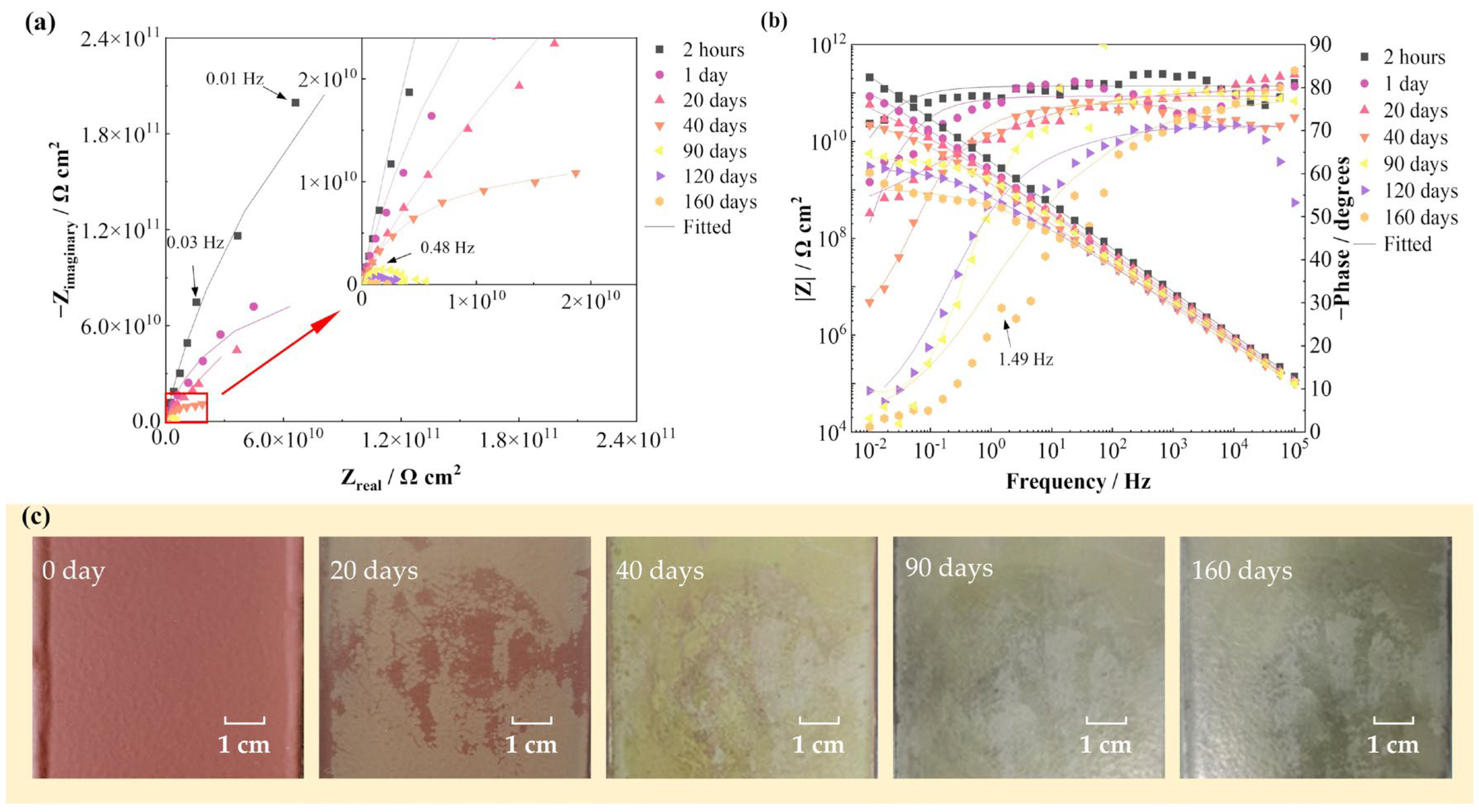

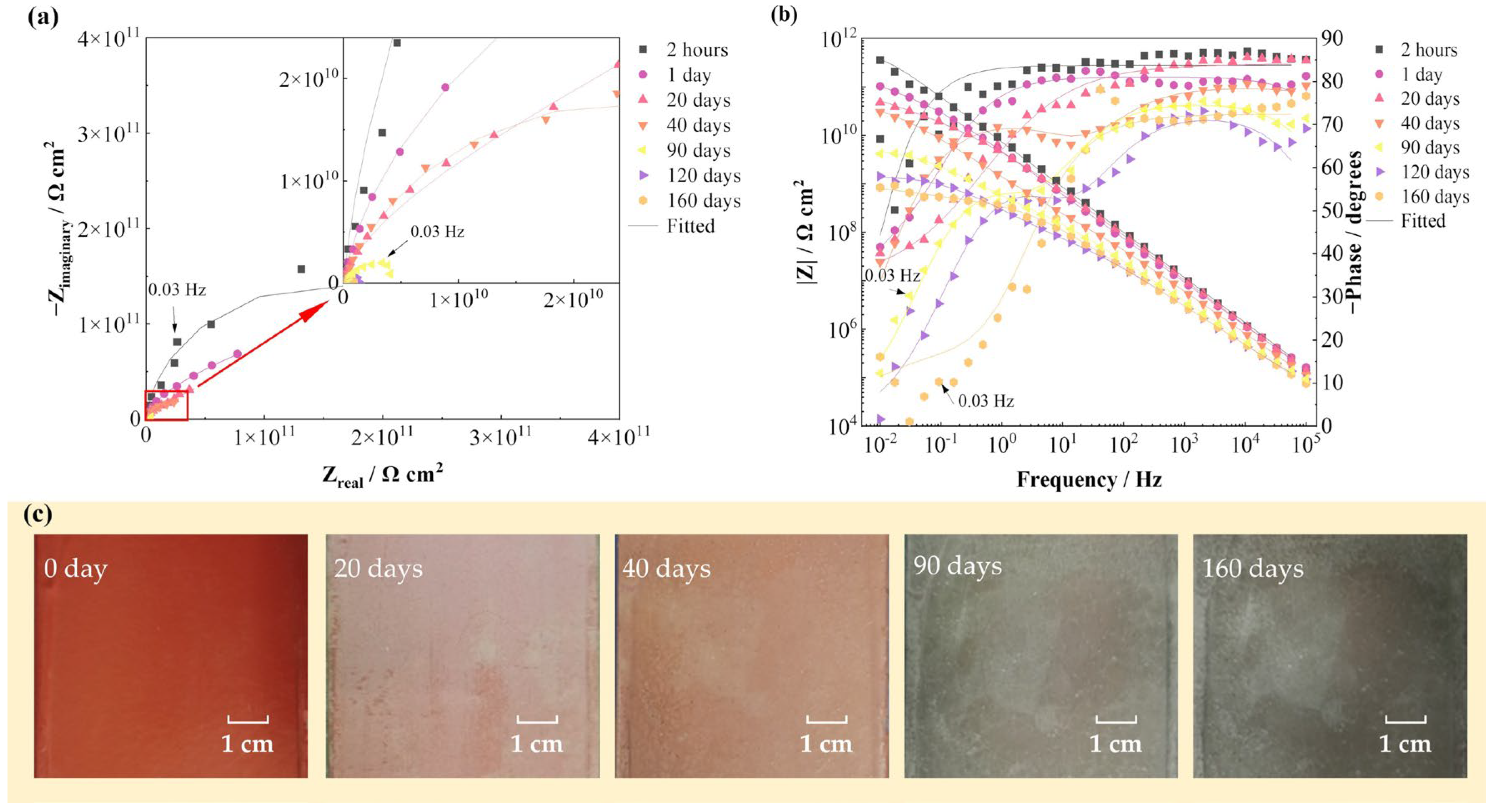
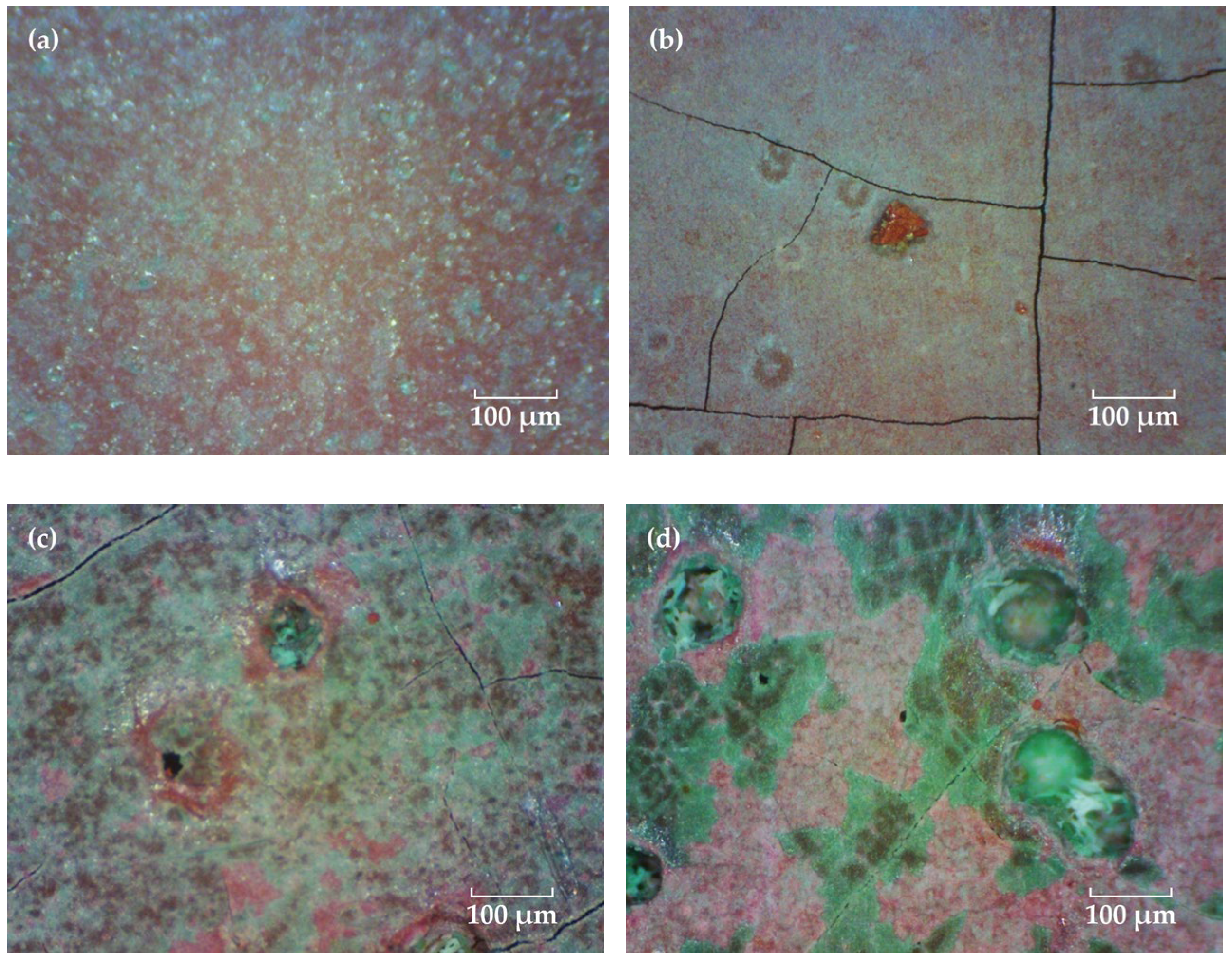
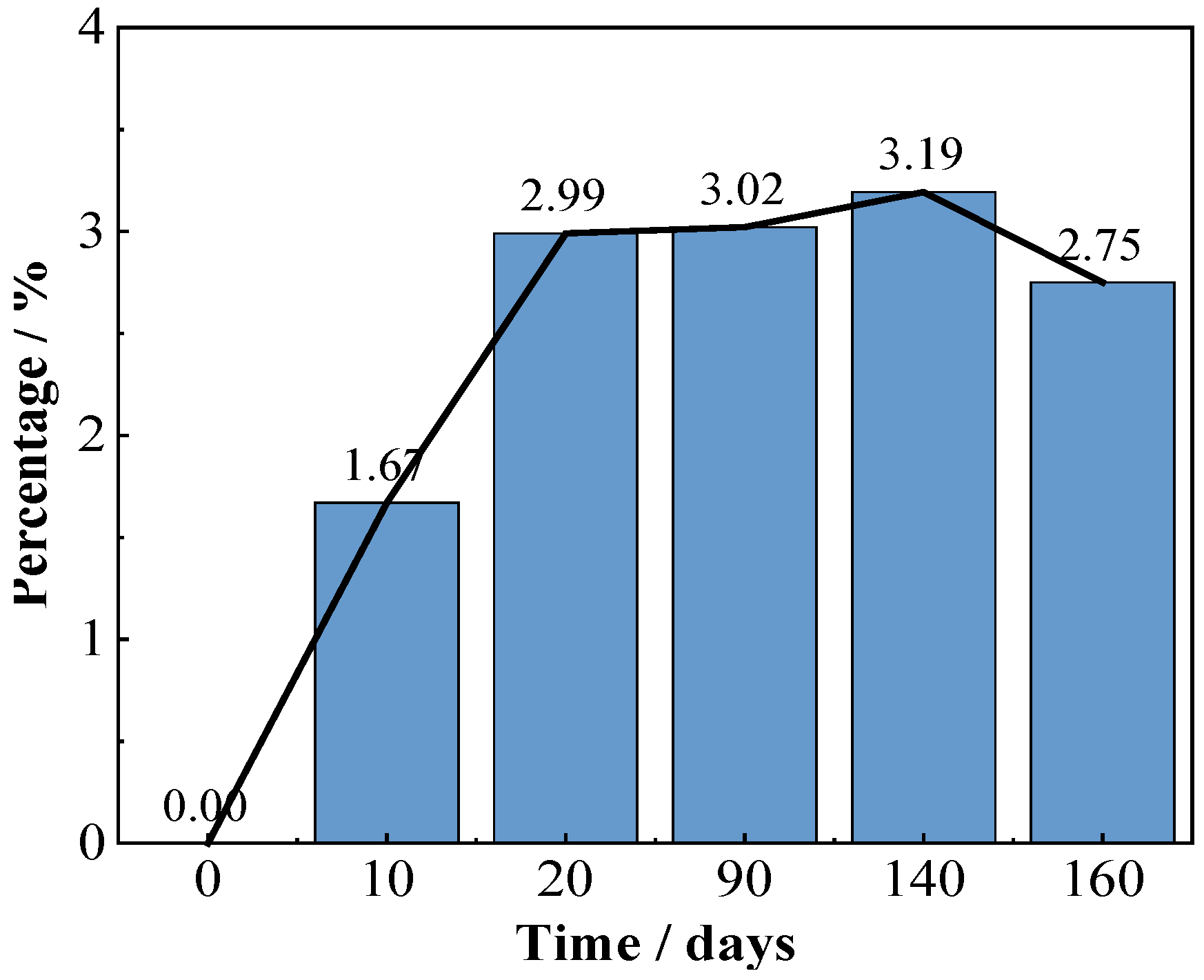
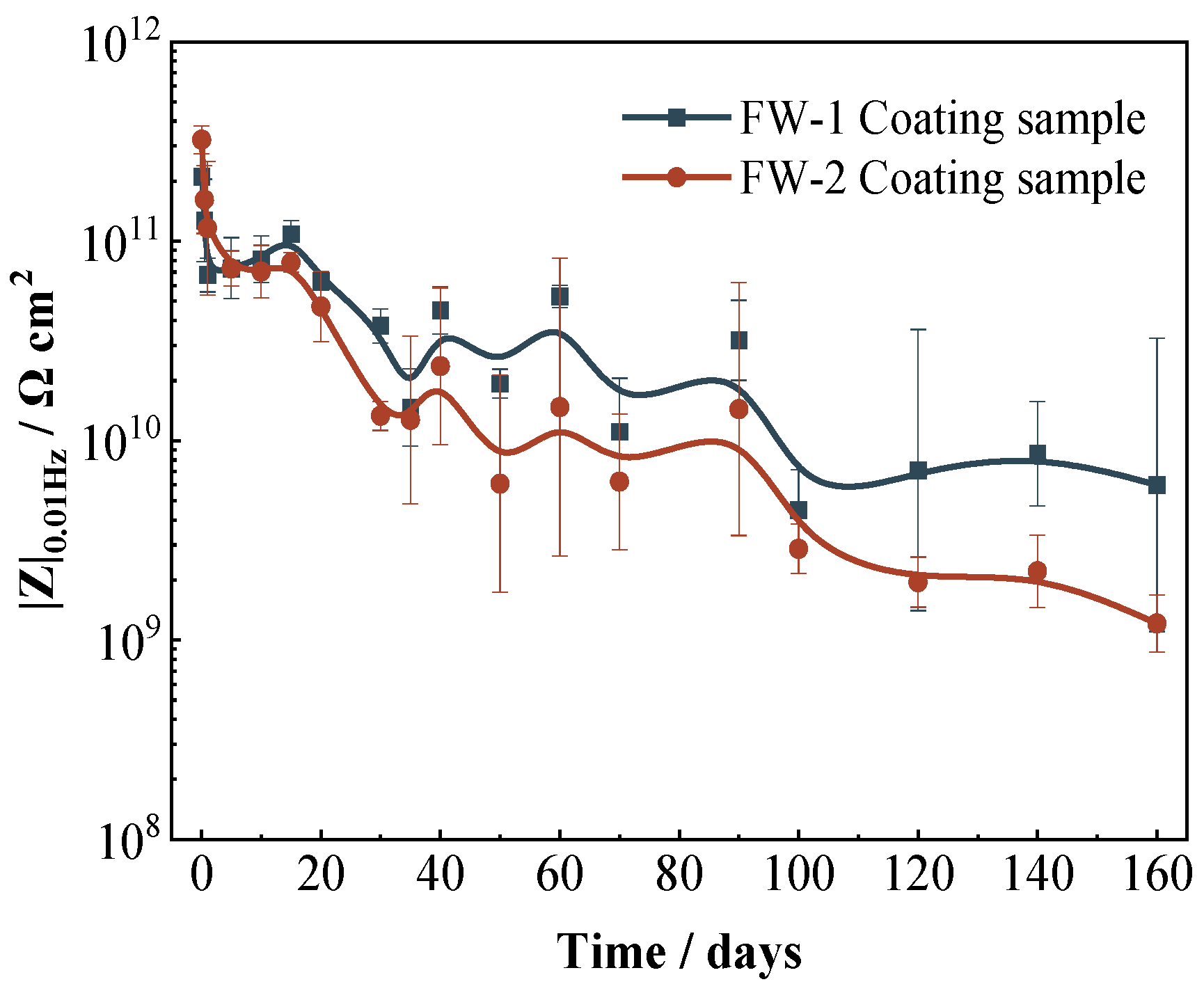
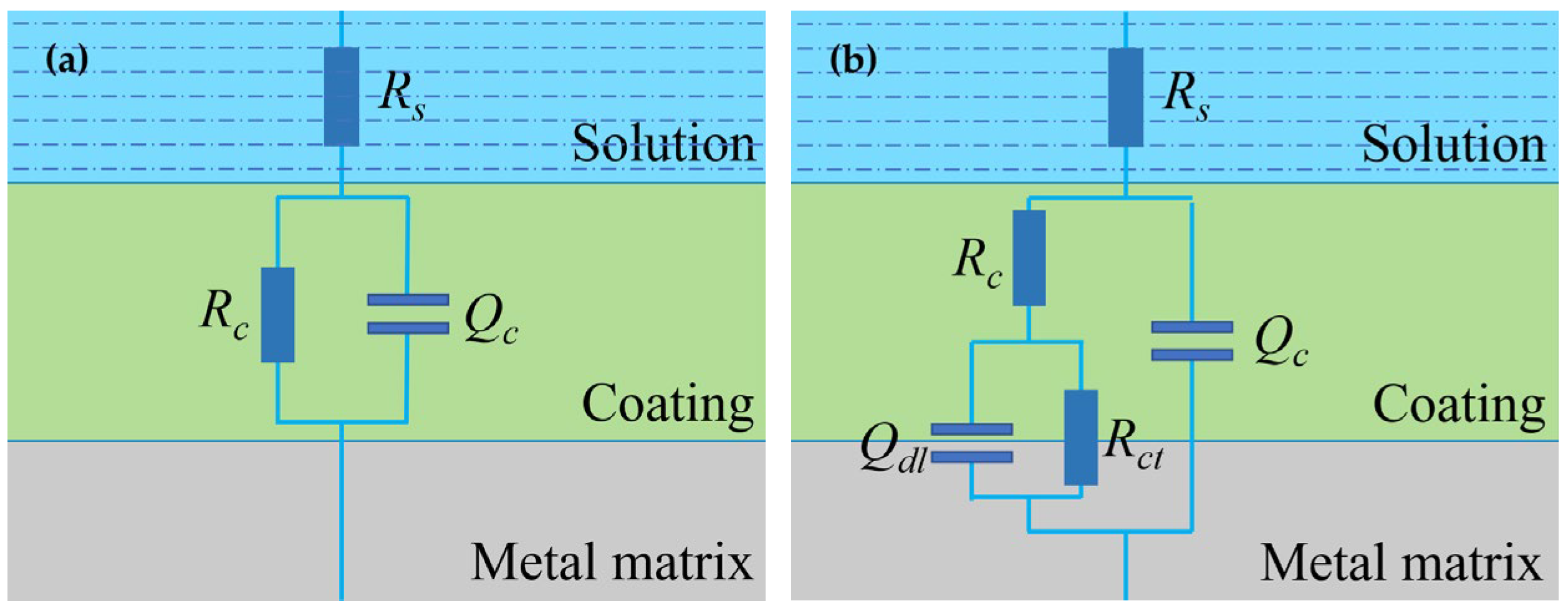
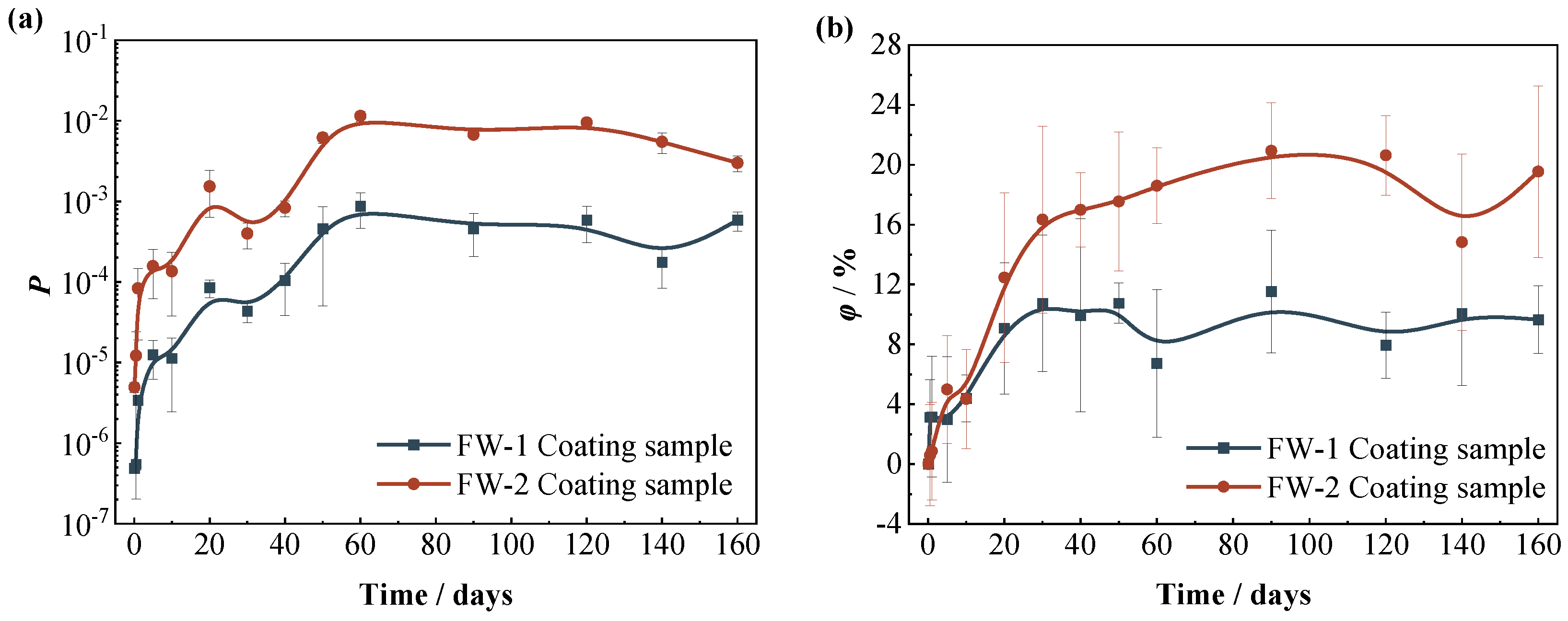
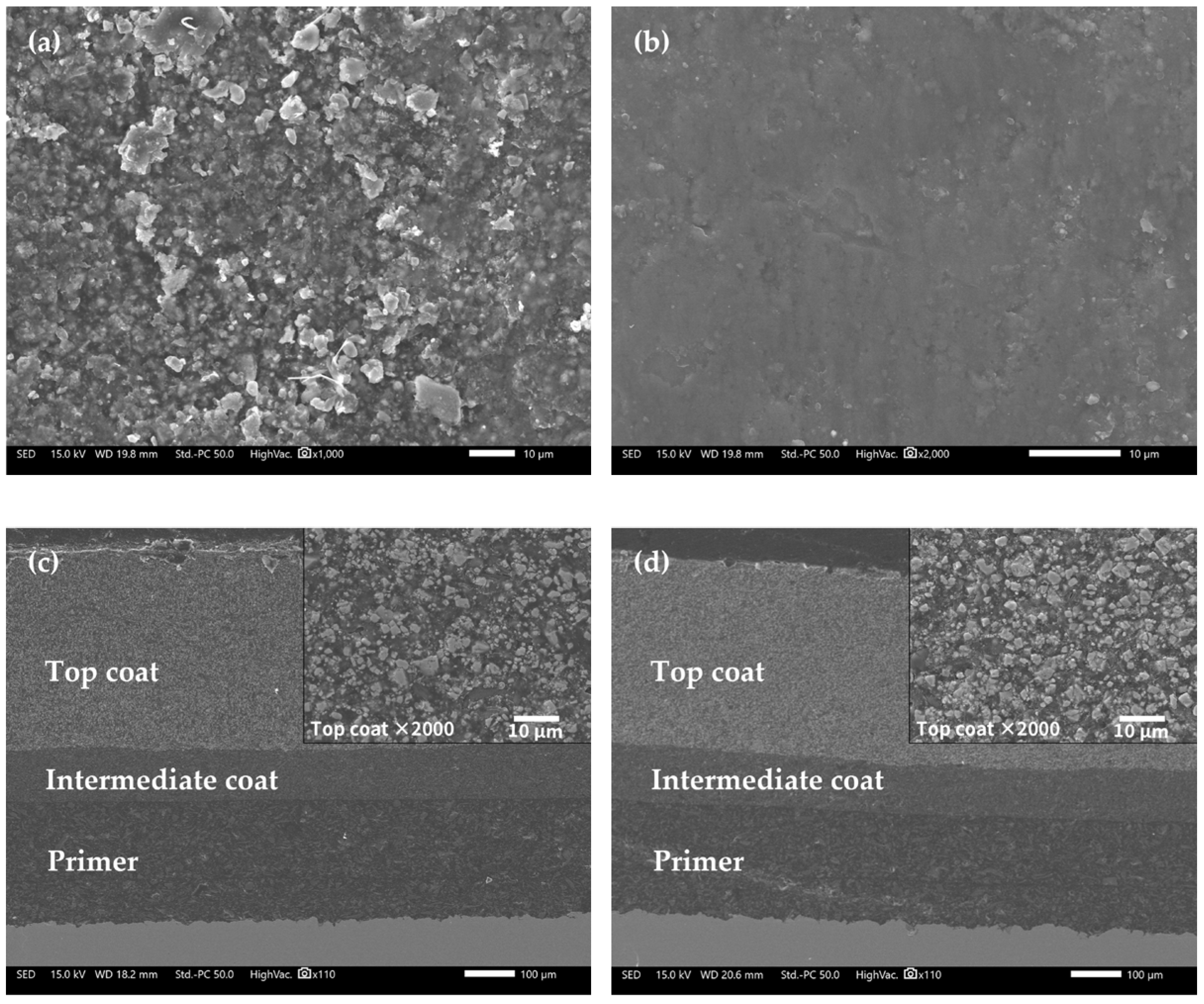
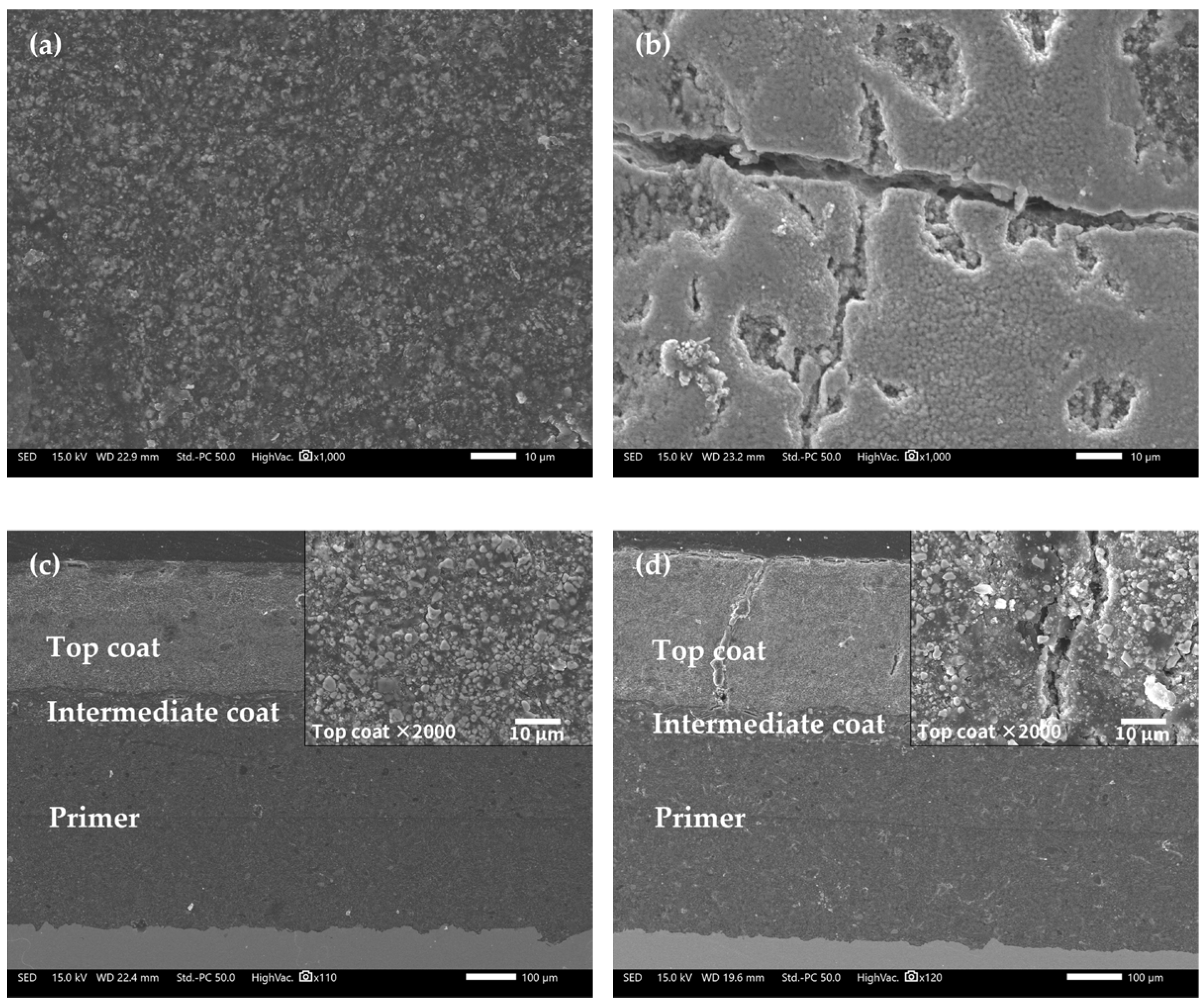

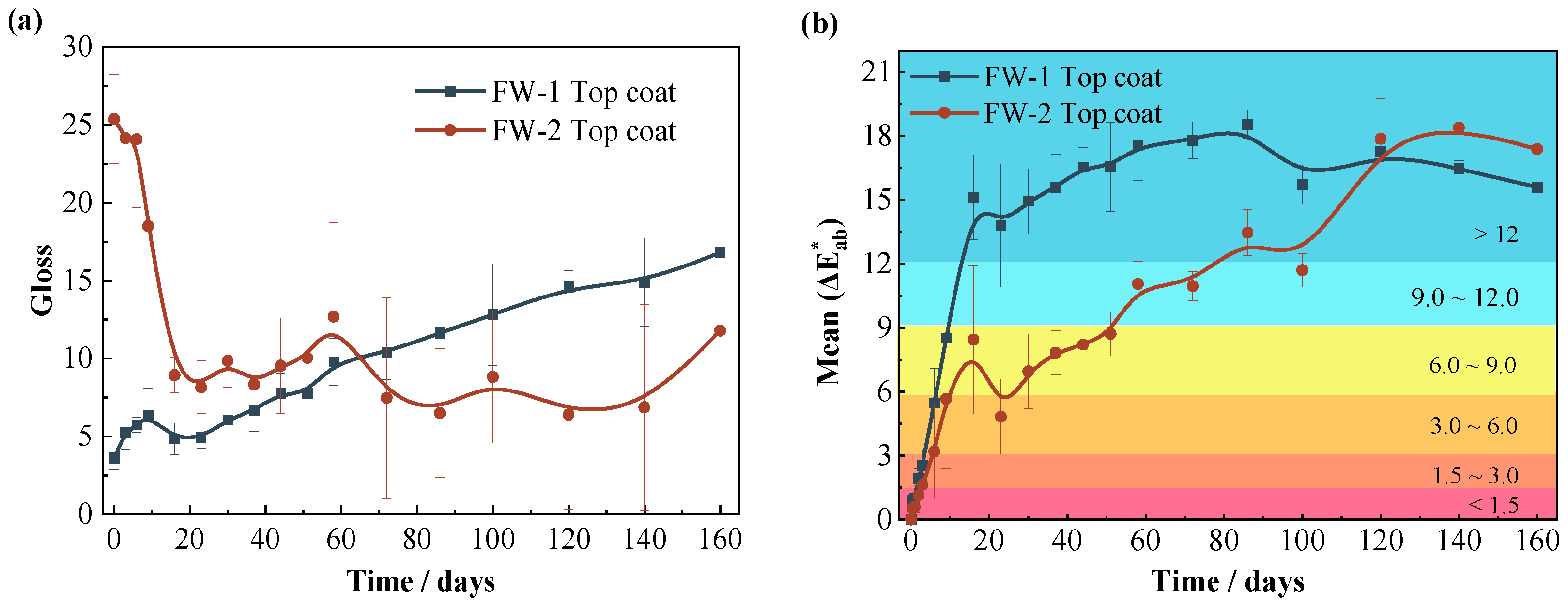
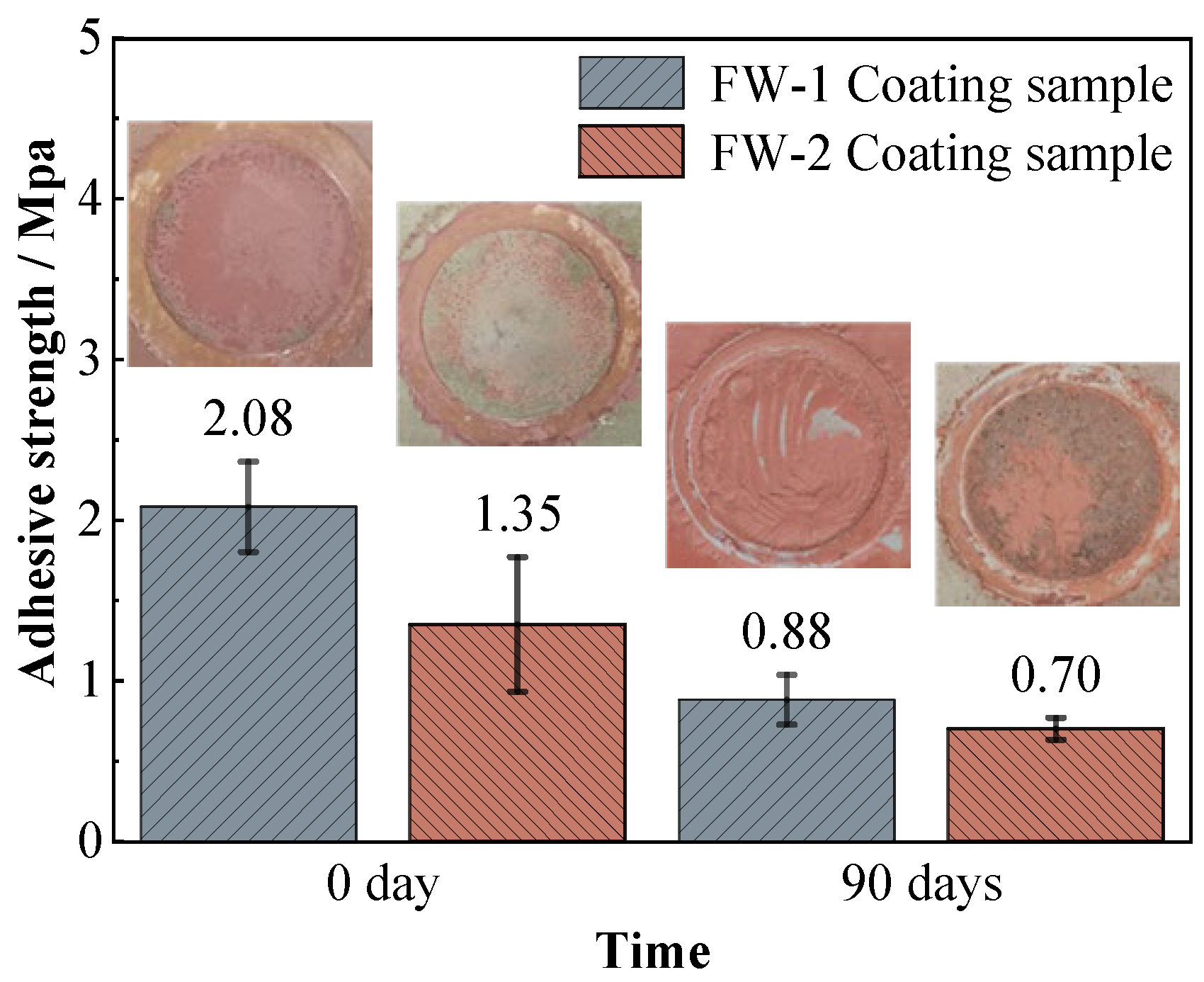
| Sample Code | Coating System | Thickness/μm |
|---|---|---|
| FW-1 | wear resistant epoxy primer | 200 ± 10 |
| vinyl epoxy based intermediate coating | 100 ± 10 | |
| self-polishing silyl methacrylate antifouling coating | 300 ± 10 | |
| FW-2 | epoxy anti-rust primer | 250 ± 10 |
| epoxy acrylic intermediate coating | 50 ± 10 | |
| self-polishing antifouling coating | 300 ± 10 |
| Time | Rs (Ω cm2) | Rc (Ω cm2) | Qc (F cm2) | nQc | Rct (Ω cm2) | Qdl (F cm2) | nQdl |
|---|---|---|---|---|---|---|---|
| 2 h | 30.31 (4.27%) | 1.03 × 1012 (16.98%) | 6.16 × 10−11 (2.09%) | 0.8946 (0.33%) | - | - | - |
| 5 days | 35.06 (4.43%) | 9.84 × 1010 (6.63%) | 8.38 × 10−11 (3.57%) | 0.8747 (0.52%) | 3.52 × 1011 (11.8%) | 6.46 × 10−11 (20.8%) | 0.7849 (10.8%) |
| 20 days | 30.18 (8.2%) | 3.95 × 109 (5.66%) | 7.88 × 10−11 (5.87%) | 0.8683 (5.38%) | 2.46 × 1011 (15.5%) | 5.78 × 10−11 (8.68%) | 0.7790 (22.52%) |
| 40 days | 28.45 (12.8%) | 7.35 × 108 (5.20%) | 3.23 × 10−9 (5.02%) | 0.8358 (4.23%) | 8.08 × 109 (8.19%) | 2.72 × 10−9 (9.6%) | 0.7596 (1.55%) |
| 90 days | 45.02 (6.68%) | 1.90 × 109 (2.22%) | 9.80 × 10−11 (20.58%) | 0.8665 (2.33%) | 4.75 × 109 (3.11%) | 2.58 × 10−10 (23.3%) | 0.7871 (4.25%) |
| 120 days | 21.07 (1.82%) | 5.76 × 108 (2.77%) | 2.14 × 10−10 (26.81%) | 0.7972 (3.24%) | 2.08 × 108 (3.02%) | 1.43 × 10−10 (4.50%) | 0.8472 (8.30%) |
| 160 days | 30.5 (1.26%) | 4.68 × 108 (4.70%) | 2.16 × 10−10 (7.06%) | 0.7748 (2.93%) | 1.20 × 107 (4.31%) | 2.74 × 10−9 (8.24%) | 0.6 681 (6.48%) |
| Time | Rs (Ω cm2) | Rc (Ω cm2) | Qc (F cm2) | nQc | Rct (Ω cm2) | Qdl (F cm2) | nQdl |
|---|---|---|---|---|---|---|---|
| 2 h | 24.94 (2.13%) | 3.09 × 1011 (19.02%) | 2.37 × 10−11 (4.70%) | 0.9378 (0.71%) | - | - | - |
| 5 days | 31.03 (7.35%) | 1.82 × 1010 (25.56%) | 3.58 × 10−11 (2.16%) | 0.9053 (0.29%) | 3.11 × 1011 (11.59%) | 1.09 × 10−10 (5.97%) | 0.6138 (7.96%) |
| 20 days | 28.48 (1.81%) | 2.75 × 108 (9.13%) | 7.82 × 10−11 (29.7%) | 0.8739 (2.68%) | 4.95 × 1010 (21.89%) | 8.90 × 10−11 (16.6%) | 0.729 (2.43%) |
| 40 days | 30 (1.60%) | 5.72 × 107 (14.97%) | 9.56 × 10−9 (4.25%) | 0.7901 (0.49%) | 6.87 × 107 (10.01%) | 1.16 × 10−9 (6.18%) | 0.7204 (2.38%) |
| 90 days | 30 (34.88%) | 6.44 × 107 (17.61%) | 1.36 × 10−10 (5.56%) | 0.8775 (0.70%) | 1.95 × 109 (12.37%) | 4.71 × 10−10 (6.23%) | 0.6618 (6.41%) |
| 120 days | 47.2 (2.15%) | 2.95 × 107 (3.68%) | 3.55 × 10−10 (14.43%) | 0.8037 (4.20%) | 1.08 × 109 (4.71%) | 2.86 × 10−8 (8.02%) | 0.6284 (6.79%) |
| 160 days | 50.3 (7.82%) | 3.71 × 107 (4.79%) | 2.63 × 10−10 (21.96%) | 0.8142 (2.73%) | 1.34 × 109 (5.18%) | 1.90 × 10−9 (1.33%) | 0.6301 (3.68%) |
| Element (wt%) | Cu | C | O | Cl | Zn | Fe | Si | Mg | S | Ti | Al |
|---|---|---|---|---|---|---|---|---|---|---|---|
| 0 day | 49.52 | 20.11 | 8.25 | 0.19 | 5.51 | 2.09 | 5.14 | 5.05 | 2.92 | 0.84 | 0.39 |
| 160 days | 46.92 | 22.27 | 14.54 | 12.05 | 2.07 | 0.65 | 0.33 | 0.64 | 0.78 | 0.13 | 0.40 |
| Element (wt%) | Cu | C | O | Cl | Zn | Si | Fe | S | Al |
|---|---|---|---|---|---|---|---|---|---|
| 0 day | 37.55 | 26.27 | 11.59 | 0.22 | 17.52 | 0.99 | 0.31 | 3.64 | 1.91 |
| 160 days | 40.51 | 25.25 | 16.57 | 9.39 | 7.64 | 0.09 | - | 0.27 | 0.29 |
Disclaimer/Publisher’s Note: The statements, opinions and data contained in all publications are solely those of the individual author(s) and contributor(s) and not of MDPI and/or the editor(s). MDPI and/or the editor(s) disclaim responsibility for any injury to people or property resulting from any ideas, methods, instructions or products referred to in the content. |
© 2023 by the authors. Licensee MDPI, Basel, Switzerland. This article is an open access article distributed under the terms and conditions of the Creative Commons Attribution (CC BY) license (https://creativecommons.org/licenses/by/4.0/).
Share and Cite
Zhang, H.; Kong, F.; Chen, Y.; Zhao, X.; Tang, Y.; Zuo, Y. Degradation of Two Anti-Corrosion and Anti-Fouling Coating Systems in Simulated Diurnal Cycling Immersion. Coatings 2023, 13, 389. https://doi.org/10.3390/coatings13020389
Zhang H, Kong F, Chen Y, Zhao X, Tang Y, Zuo Y. Degradation of Two Anti-Corrosion and Anti-Fouling Coating Systems in Simulated Diurnal Cycling Immersion. Coatings. 2023; 13(2):389. https://doi.org/10.3390/coatings13020389
Chicago/Turabian StyleZhang, Hanlu, Fabao Kong, Yiyang Chen, Xuhui Zhao, Yuming Tang, and Yu Zuo. 2023. "Degradation of Two Anti-Corrosion and Anti-Fouling Coating Systems in Simulated Diurnal Cycling Immersion" Coatings 13, no. 2: 389. https://doi.org/10.3390/coatings13020389
APA StyleZhang, H., Kong, F., Chen, Y., Zhao, X., Tang, Y., & Zuo, Y. (2023). Degradation of Two Anti-Corrosion and Anti-Fouling Coating Systems in Simulated Diurnal Cycling Immersion. Coatings, 13(2), 389. https://doi.org/10.3390/coatings13020389






